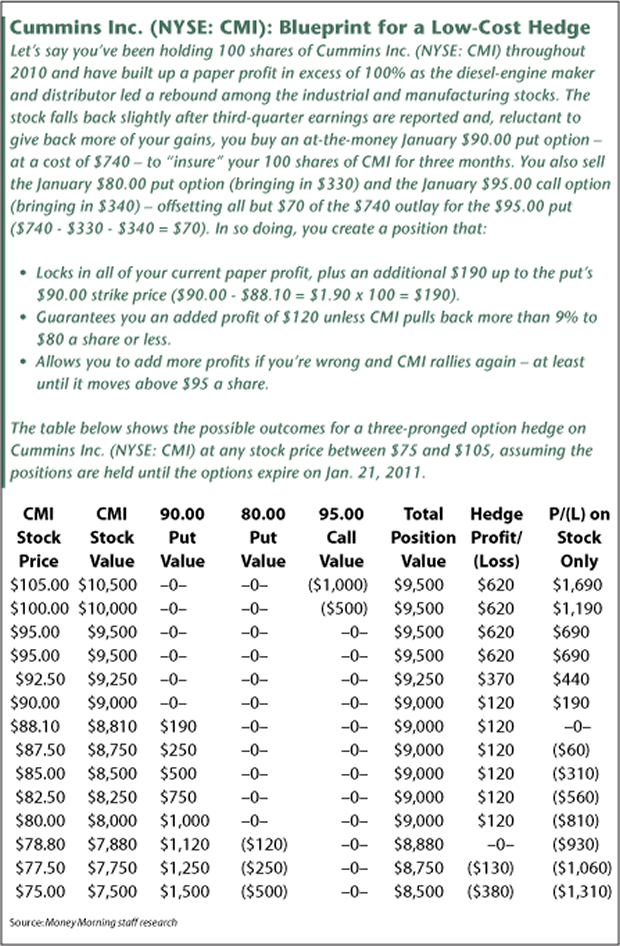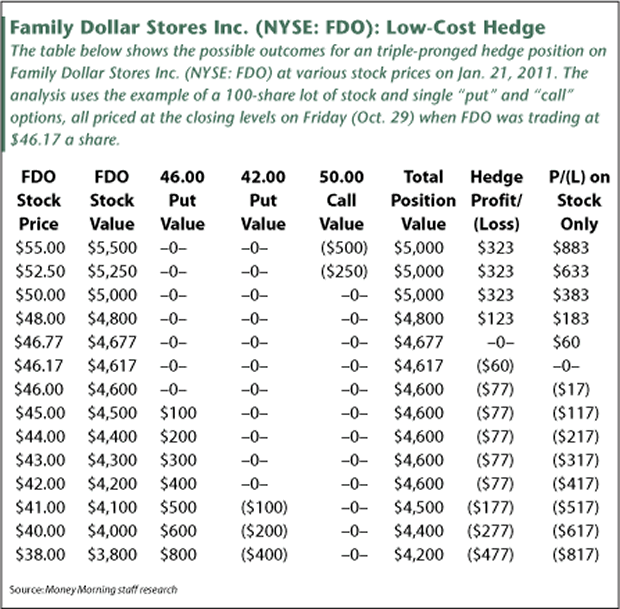How to Protect Your Portfolio with Stock Options Insurance Policy
InvestorEducation / Learning to Invest Nov 02, 2010 - 07:43 AM GMTBy: Money_Morning
 Larry D. Spears writes:If you don't deal a lot with stock options in your investments, you probably don't realize just how versatile options actually are.
Larry D. Spears writes:If you don't deal a lot with stock options in your investments, you probably don't realize just how versatile options actually are.
In fact, stock options can be used:
•As a low-cost way to speculate on expected price movements.
•To generate some added income on stock holdings.
•To hedge against market reversals.
•And even as a form of "insurance" - when used to "lock in" gains on profitable positions, protecting those profits against such stock-market reversals.
Using Options as "Profit Insurance"
The latter strategy typically involves buying "at-the-money" (ATM) put options on your "long" stock positions. This creates a situation akin to an "insurance policy" in that your profit on the put options will offset most - or even all - of the erosion of your paper profits or even the outright loss on your stock, should stock prices turn lower during the life of the option.
Such hedges have particular appeal when stock prices have made a nice move higher - as they did in September and October. What's nice is that they give you a strategy option other than just "cashing out." They enable you to remain invested and play for the continuation of the upward move without risking too much of the profit you've already made.
The only problem is that dramatic price moves - whether up or down - tend to increase the market's perception of potential risk, causing option premiums to rise sharply. This makes the purchase of such "insurance" extremely expensive.
For example, on only a moderately volatile stock, an at-the-money put option with two months of life left currently costs around $500 for each 100 shares. That means the stock price would have to fall more than $5.00 a share before the insurance provided by the put would kick in.
Fortunately, there is a solution for this problem - a way to structure an option hedge that will give you virtually instant downside protection, and do so at little or no cost.
What you do is buy the protective at-the-money put, as in the basic strategy, and simultaneously sell (or "write") both a deep out-of-the-money (OTM) put and an out-of-the-money call option.
The sale of the put creates a bearish spread that will insure your stock position down to the strike price of the put you sell, offsetting any drop in the price of the underlying shares.
The sale of the call brings in enough added money to offset most or all of the cost of the put you buy for protection, while also allowing you to pick up a limited amount of additional profit should your concerns prove unfounded and the stock price continue to rise.
The position carries no additional margin requirement because the stock you hold "covers" the call you sell, and the at-the-money put you buy as insurance covers the put you sell.
A Case Study With Cummins
If you're not entirely familiar with options and their terminology, a couple of examples should help clarify how to structure the trade and explain how the strategy works.
[For simplicity - and to make it easier to calculate the potential trade outcomes - we'll use a 100-share lot of stock and single options in our examples, all based on actual prices available on Friday (Oct. 29).]
Assume you sold a couple of unprofitable positions in late December 2009 in order to take a tax loss, replacing one of them by purchasing shares in Cummins Inc. (NYSE: CMI), one of the world's largest makers of diesel and clean-burning natural gas engines (and a Money Morning "Buy, Sell or Hold" recommendation earlier this year). Your assumption was that industrial and manufacturing companies, which had been hard hit during the 2008-2009 downturn, would benefit most during any economic rebound in 2010. At the time, CMI was priced at $45.86 per share, meaning 100 shares would have cost you $4,586. (For the sake of clarity, we'll ignore the modest commissions in our examples.)
Although the 2010 economy proved to be less robust than hoped for - and the overall markets suffered a sharp pullback from April through June - prices rebounded nicely during the early autumn, with Cummins among the market leaders. In fact, by late October, it had climbed to near $95 a share, up more than 105% on the year.
The question you now must ask yourself is this: Do you believe that there will be enough of a continued improvement in the economy - albeit slow - to continue to benefit Cummins?
That was your belief, but then Cummins missed projections slightly when it reported third-quarter earnings last week and the stock dropped more than $5 a share.
In your opinion, that was an over-reaction - especially since the profits CMI reported were three times higher than a year earlier. But you didn't want to risk giving back any more of your hard-won profits, should the pullback continue. So you decided to buy an at-the-money $90.00 put option to lock in your gains.
However, a glance at the CMI option price tables showed that, with Cummins closing at $88.10 on Friday (Oct. 29), the January 90 put was priced at $7.40. That meant it would cost $740 to "insure" your 100 shares of CMI for just under three months - and the insurance wouldn't even pay off until the price of Cummins stock fell to $82.60 ($90.00 - $7.40 = $82.60).
That seemed a hefty price to pay for some short-term protection, but a look at some other option prices presented an alternative. The January 80 put was priced at $3.30 ($330 for the full contract) and the January 95 call option was quoted at $3.40 ($340). If, in addition to buying the January 90 put at a cost of $740, you also sold the January 80 put and the January 95 call, you'd wind up with a net debit of just $70 on the three-pronged hedge ($740 - $330 - $340 = $70).
Even better, you would be creating a position that:
•Locked in all of your current paper profit - plus an additional $190 - up to the $90.00 strike price of the put you sold ($90.00 - $88.10 = $1.90 x 100 = $190).
•Guaranteed you an additional profit of $120 (the $190 strike-price differential, minus the $70 debit), unless CMI pulled back more than 9% and fell below $80 a share prior to mid-January 2011.
•Allowed you to add more profits if your concerns proved wrong and CMI rallied again - at least until it moved above $95 a share.
To clarify these advantages, the following table shows all the possible outcomes for this strategy at any Cummins share price between $75 and $105 per share (assuming the positions are held until the option expiration on Friday, Jan. 21, 2011).

The strategy will work equally well across different time frames and with lower-priced stocks, though the amount of downside protection on shorter-term hedges will be reduced somewhat by the smaller premiums for the options.
A Low-Cost Hedge for a Hefty Gain
As an example, the table below shows the potential outcomes for a hedge on Family Dollar Stores Inc. (NYSE: FDO), a low-cost retailer that also did well in 2010's struggling economic recovery. Had you bought the stock at its year-end 2009 price of $27.83, you'd have been sitting on a profit of 65.9% as of last Friday (Oct. 29).
A gain that hefty is well worth protecting with a low-cost hedge.
Values in the table are based on Friday's FDO close at $46.17, with the January 46 put priced at $2.35, the January 42 put at $0.95 and the January 50 call at $0.80 - meaning the full three-pronged hedge cost only $60 to initiate and limited your loss to just $77 so long as FDO stayed above $42 a share prior to the January 2011 option expiration.

Obviously, if your concerns prove to be unfounded and the stock you're hedging resumes its upward course, this strategy will limit your future profits (unless you buy back the call you sold). However, if you have gains on an existing position - or are worried about a pullback on a holding that hasn't yet made an upward move - this strategy can be a highly effective means of protecting yourself.
And depending on the strike prices and premiums of the out-of-the-money options you choose to sell, you can get that protection at virtually no cost.
Actions to Take: In a market as uncertain as this one, it pays to think and invest defensively. Two moves in particular are worth considering.
First, in cases where you have a big profit in a stock - but want to keep holding it - consider the stock-option "insurance policy" outlined in this report.
And, second, take some time to look back through Money Morning's "Defensive Investing" series for other defensive strategies that are appropriate for this market.
[Editor's Note: Article author Larry D. Spears is an options expert. A veteran journalist and longtime chronicler of the global financial markets, Spears has also written several books on financial topics - including the options-strategy primer: "Commodity Options: Spectacular Profits With Limited Risk." In another recent contribution to Money Morning's "Defensive Investing" series, Spears illustrated how writing covered call options can increase your cash flow and provide added protection for your long-term stock positions.]
Source : http://moneymorning.com/2010/11/02/...
Money Morning/The Money Map Report
©2010 Monument Street Publishing. All Rights Reserved. Protected by copyright laws of the United States and international treaties. Any reproduction, copying, or redistribution (electronic or otherwise, including on the world wide web), of content from this website, in whole or in part, is strictly prohibited without the express written permission of Monument Street Publishing. 105 West Monument Street, Baltimore MD 21201, Email: customerservice@moneymorning.com
Disclaimer: Nothing published by Money Morning should be considered personalized investment advice. Although our employees may answer your general customer service questions, they are not licensed under securities laws to address your particular investment situation. No communication by our employees to you should be deemed as personalized investent advice. We expressly forbid our writers from having a financial interest in any security recommended to our readers. All of our employees and agents must wait 24 hours after on-line publication, or 72 hours after the mailing of printed-only publication prior to following an initial recommendation. Any investments recommended by Money Morning should be made only after consulting with your investment advisor and only after reviewing the prospectus or financial statements of the company.
Money Morning Archive |
© 2005-2022 http://www.MarketOracle.co.uk - The Market Oracle is a FREE Daily Financial Markets Analysis & Forecasting online publication.



